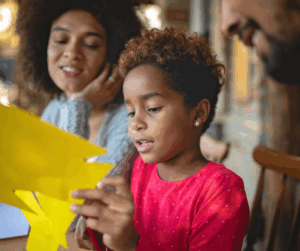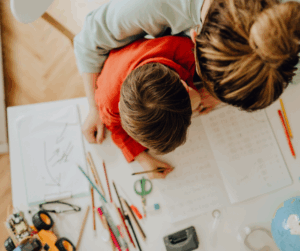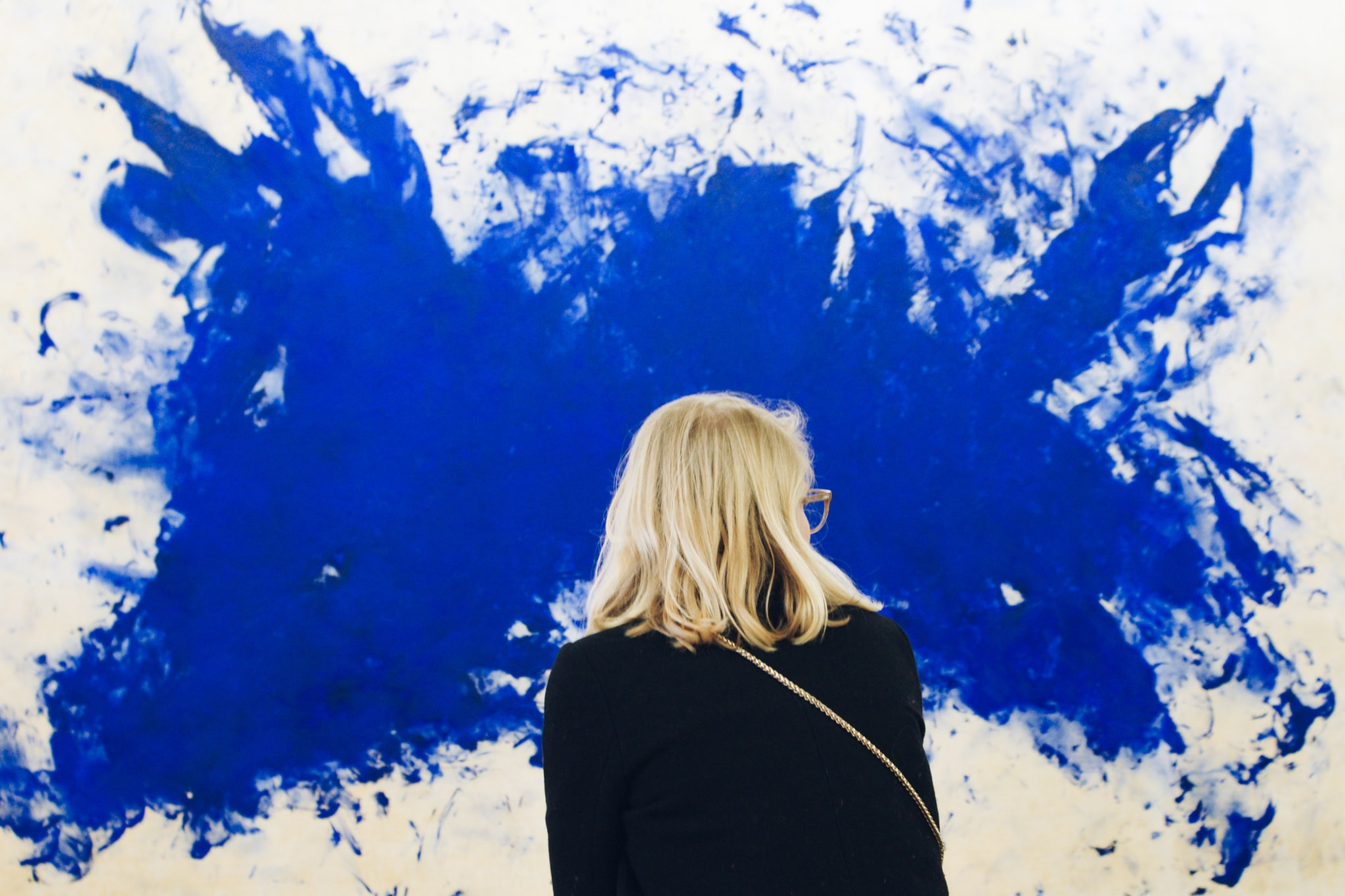When you think about the most important subjects for children to learn, what immediately comes to mind?
If you are like many parents (or teachers), your brain probably immediately goes to the “cornerstone” academics: literacy, math, grammar. Then you might think of history or science. And subjects like art (and music and drama) probably come last, right? Even if you love the arts, it’s just easy to fall into thinking of them as “extracurricular,” activities. This carries the unspoken implication that they are “extra,” or not totally necessary– the symbolic icing on the cake.
Today, I’m here to argue with that mentality. The truth is that students need art, and they need art education. Studying art provides unique benefits that more traditional subjects sometimes can’t provide. In today’s post, I’m sharing some of the reasons that students desperately need more art in their lives, and the things that art education can do for them: academically, developmentally and emotionally.
At Sparketh, we’re passionate about making arts education affordable and virtually available to kids everywhere, whether they are homeschoolers, private or remote schoolers, or public schoolers in search of additional artistic support. We aren’t just passionate about art for art’s sake, either. We love art because of the positive impact it can make in the lives of kids and teens. In the busy rhythm of their day-to-day activities, kids and teens are often missing this critical piece of their education, and that’s a gap we want to help fill.
Bottom line? Students need art. Here are 10 reasons why.
1.Drawing Helps You See Things Differently
When you engage in art, particularly drawing, you experience a shift in perspective. This can be especially true when you are looking at something and carefully trying to recreate a drawing of it. When you study an object to recreate it with art, your brain is forced to make new observations about everyday shapes and objects that it might not have paid attention to before.
With a pencil in hand and some motivation to focus, your brain is forced to find new ways to perceive something familiar.
This is actually a wonderful practice for anyone (especially children and teens) for several reasons. For one thing, this shift in perspective can be very calming (more about that later). It also hones observational skills, which children are in the process of developing. The practice of learning to view familiar things in a different way can help develop more open-minded ways of thinking. For example, if you are trying to draw a vase that’s been sitting in your living room at home for so long that you never really stopped to look at it closely before, you may suddenly notice all kinds of interesting colors and textures. With regular art practice, students start to look the world around them with more curiosity, observation and understanding than before.
The Hemisphere Switch:
A very well-known researcher and author, Dr. Betty Edwards, proposes that this perspective shift in drawing increases communication between both hemispheres of the brain. In her book, Drawing with the Right Side of the Brain, she describes how learning to draw teaches the brain to quickly make a mental shift between L-mode (left brain mode which is rational) and R-mode (right brain mode which is intuitive). (You can check out her website to read more about it.)
It’s amazing how something as simple as the practice of drawing may make such an impact on a child’s perception of the world around him/her. If you are thinking about signing up your child for online art courses via Sparketh, there are many drawing classes to choose from that can help build drawing skills (as well as the skills I’ve mentioned). I’d specifically suggest some courses that focus on perceiving and drawing everyday objects or scenes (there are several here to choose from!)
2. Art Helps with Anxiety
Art can be a great coping mechanism for stress and anxiety. While this is true regardless of age, art is thought to be particularly helpful for anxious children and teens. In fact, art therapy is a very popular method for helping children and teens cope with mental and emotional health challenges.
One reason is that art can be an effective outlet for letting out anxiety and negative emotions. Often, children and teens may not know exactly what is bothering them, let alone how to express it verbally. Art gives them a way to get frustration out, and the process may also help them (as well as those who care about them) understand what’s going on inside.
Another reason that art can be helpful for anxiety is the perspective shift discussed in point #1. Creating something can be a great way to get out of a funk and focus on something external, productive, and within our control. It’s kind of like meditation that way!

3. Art Teaches History in An Immersive Way.
We can learn a lot about particular time periods, events and historical figures through studying art. Portraits offer a lot of insight into the values of a specific time and place, as does the study of the most prominent art style of a particular time. (In fact, we have a whole article on that here.)
Throughout history, trends in art also reflect trends in thinking. Furthermore, just as historical movements often demonstrate opposite reactions in thinking, so do art styles. This is a concept that students usually don’t learn about until high school or college, but they can easily see and learn it at a younger age through art education.

Little Girl in a Blue Armchair (1878), Mary Cassatt
If you’re interested in using art to help your child get some hands-on support with history, this unique online art track was developed to teach students all about 10 different portrait styles while also exploring the history behind them. It’s a great way to bring some life and creativity into your child’s study of history, (or some history into your child’s study of art!)
4.The Creative Process Builds Decision-Making Skills
The ability to think creativity and critically is a valuable life skill, and it’s one that art helps to build. The process of creating art is all about making decisions, such as:
- Which medium should I use?
- Is there a particular style that will fit this best?
- What colors will I choose?
- How do I want the viewers to feel, and how will I guide that?
- Should I stop now, or is it finished?
No one can make these decisions but the artist, and often one decision will affect another. Because of this, art can be a powerful tool for helping young people hone the important developmental skill of decision-making. Decision-making, in turn, helps children and teens become more in tune with their own ideas and thoughts. This article, The Importance of The Creative Arts for Children and Teens, puts it this way:
“Everyone has an imagination. Art takes it a step further. Through art, children create something that, until that point, was only imagined. Thus, they create visual manifestations of abstract ideas.”
Art helps students thoughtfully bring abstract ideas to life, and that’s pretty powerful.
5. Art Teaches Expression/ Communication
Going hand-in-hand with items #2 and #4 is the fact that art offers children a unique way to communicate.
Art is often a more accessible form of expression than verbal or written communication, especially for kids and teens who don’t often have the ability to articulate their experiences into words. Additionally, decision making skills (again, encouraged by art), can help young people discover more about their own thoughts and preferences.

The ability to understand and communicate ones thoughts and feelings is one that will benefit children and teens in adulthood. Children and teens who have learned how to communicate through art may also find that it positively impacts their ability to relate to and communicate with others.
6. Art Enhances Memory and Focus
Another great reason to include art in your homeschool curriculum is that it actually enhances thinking, memory, and focus! Research suggests that art actually helps the different hemispheres of the brain communicate with each other. Beyond this, a study of the arts (in any form) may also help children train themselves how to concentrate.
This examination on the ability of art to inhance focus and cognition indicates that, because many young people find themselves drawn to the arts, it can be a voluntary way for them to immerse themselves in a cognitive activity. This, in turn, can actually train the brain to focus for longer periods of time.

In other words, because a student enjoys the mental work that comes with art, he or she is more likely to commit long periods of time to focusing on it. Art is a fun way to train your brain to focus. When you use art to regularly train your brain to focus, you’ll be able to use those newfound powers of concentration whenever you need them.
7. A Personal Investment in Art Teaches Self-Discipline
Just like an interest in art can help train your child’s brain to focus, it can also be a way for them to learn about self-discipline. Children and teens who are interested in art may find themselves actually wanting to spend time, money, and effort on learning how to grow their skills. Essentially, this means that a love of art can introduce a student to the concept of self-learning, and even self-discipline.
An interest in art can actually be (and often is) the thing that teaches children and teens how to independently pursue something that excites them. Students who challenge themselves to grow their skills through learning are also learning how to be self-disciplined and independently motivated!
8. Art Can Be a Platform for Connection
Art camps, classes, and local projects, all offer opportunities for your artistic child or teen to connect with like-minded individuals. Online communities can also be a great place for your student to connect with art mentors, teachers, and peers who are share their love of art. Because we believe in the power of community, Sparketh actually sponsors a free Sparketh Community (open to all kids and teens, not just members.) It’s a place where artsy kids and teens can connect, complete monthly art challenge (with prizes), and support one another. You can find out more here.
In addition to filling an important social and emotional need, connecting with other artists at a young age can be a valuable professional resource in young adulthood. If your child ultimately decides to pursue a career in an art-related field, it will be good for them to know others within this field who may be able to provide advice, support, or professional recommendations!
9. Art Encourages Making Mistakes
No, you didn’t misread anything. Students need art because it encourages making mistakes.
Trying new things, taking risks, and making mistakes are super important facets of learning and maturing. These things teach us to how figure out what works and what doesn’t. They also guide us in tweaking “good” until it becomes “great.” Mistakes also build perseverance. They show us that we can keep moving forward, even when we don’t get it perfectly right the first time. Research indicates that having the freedom to make academic mistakes can observably improve a child’s ability to learn.

The problem is that many children feel such a pressure to get things right the first time that they may feel very anxious about making mistakes. Enter art.
As I talked about earlier, the creative process provides limitless opportunities for decision making. These decisions also offer the chance for children and teens to think about how they may like to do it differently, next time. With art, there are limitless opportunities for risk-taking and mistake making in a relatively safe space. When we have freedom to make mistakes, that’s probably when we learn the most!
10. Art Helps Build a Strong Sense of Self
Finally, students need art because it helps to develop a strong sense of identity. Think about it this way:
As we’ve discussed, incorporating art into you a student’s regular routine can help them grow in the following areas:
- Decision making
- Communication
- Self-motivation
- Focus
- Perseverance
- Social connection
- Risk taking and perseverance
You can see how these are all valuable qualities for a child or teen to develop (or have begun developing) by young adulthood. Art, and art education, helps children develop a clear picture of who they are and how they connect to the world around them. While “art for art’s sake,” is a valuable pursuit on its own (especially if you have a child who has a natural interest in it), it is also a valuable tool to help kids and teens find their way. Growing up is hard, and art can be a positive force in the midst of it.
Have you considered making art courses a part of your child or teen’s daily life ? Do you have a student who is naturally interested or gifted in art, or are you interested in it for some of the other reasons mentioned above? We want to know!



